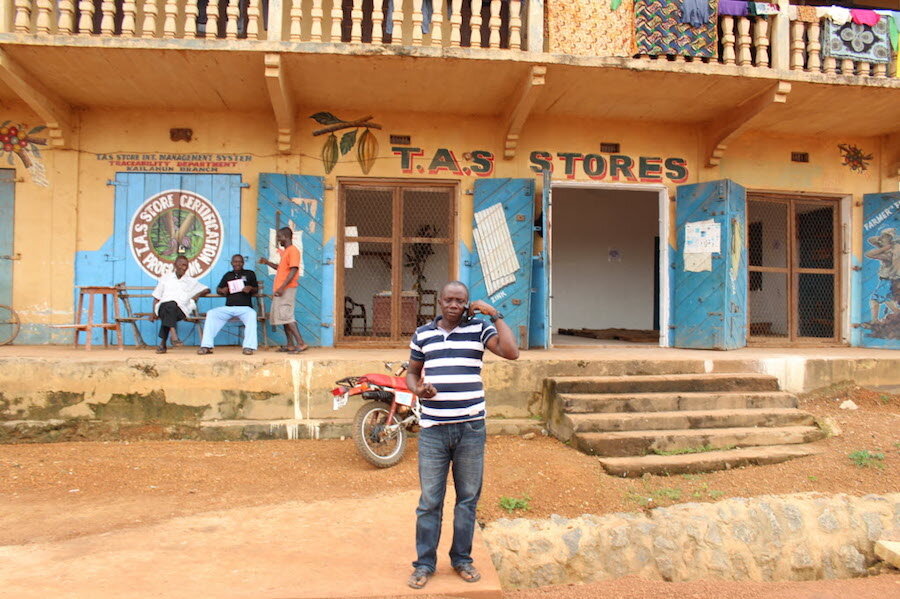As Ebola crisis ebbs for Sierra Leone, food insecurity gnaws at recovery
Loading...
| Kailahun, Sierra Leone
The cargo trucks that ply the dirt roads from this rural inland district west towards Sierra Leone’s cities and ports sag with the weight of the region’s harvests: sacks of burnt orange palm nuts, fragrant dried cacao and hard coffee beans. But they also carry clues to its hopes and fears, spelled out in the messages drivers paint in bold black letters across their front fenders.
“Tomorrow is another day,” promises the text emblazoned on an ancient Mercedes truck wheezing up a steep red hill. “Don’t give up,” implores another. “Your miracle is on its way.”
In the shadow of the worst Ebola outbreak in recorded history, these mobile billboards suggest a halting, ginger optimism returning to an agricultural region that was once Ebola’s ground zero in Sierra Leone.
Today, the virus appears to be in retreat. Massive tented treatment centers built by international donors stand vacant and ghostly across the countryside, unnecessary to cope with the single-digit numbers of new cases recorded in recent weeks. Schools, closed for nearly nine months, have reopened. On weekend mornings, Freetown’s Atlantic Ocean beaches are once again thronged with joggers, pick-up soccer games, and informal aerobics classes, as fears fade of passing Ebola through physical contact.
While life on its surface seems almost eerily normal, however, the region's recovery is still in the balance. Ebola is no longer such a deadly killer, but its impact is still leeching life from poor economies in West Africa — dramatically reducing output in industries from mining to tourism in ways that economists say are only beginning to be felt. In Sierra Leone, where two-thirds of the population farms, nowhere was the pain more widely felt than in agriculture. An initial assessment by the United Nations Food and Agriculture Organization near the end of 2014 suggested that more than a third of farmers in parts of eastern Sierra Leone had either abandoned their farms or died.
“For an entire growing season, we lived in a state of emergency, where people didn’t move and couldn’t trust each other,” says Lahai Momoh, a buying agent in Kailahun for T.A.S., one of Sierra Leone’s largest exporters of cacao, a major cash crop.
“This was the worst year of my career since the [civil] war, and at least during the war you knew where the enemy was. With Ebola there was no escape.”
Abandoned farms
In the weeks after Sierra Leone's first confirmed Ebola case in late May 2014, this rural eastern district of Kailahun — which presses up against porous land borders with Guinea and Liberia — went into lockdown. A district state of emergency on June 12 shuttered schools, cinemas, and bars, and checkpoints appeared along major roads to test travelers for abnormally high fever, Ebola’s earliest warning sign. Large gatherings were forbidden, and farmers could not hire laborers to harvest their crops.
But the disease still refused to stay put. By August, it had migrated north and west to 10 of Sierra Leone’s 14 districts, and the region where the disease first crossed into the country was put under a strict quarantine. With few exceptions, no one came in, no one went out.
“If you’re a farmer, how do you get people together to harvest your fields in those circumstances?” says Yatta Samah, a veteran farmer, women’s rights activist, and politician in Kenema, the district adjacent to Kailahun. “It’s impossible. And that is not mentioning the trauma that so many farmers endured from the disease itself.”
In a year when cacao production had been predicted to rise, it instead sank, from 13,253 metric tons in the 2013/14 harvest season to 12,642 metric tons the following year, according to Sierra Leone’s Produce Monitoring Board. Overall, Sierra Leone’s economy, which had expanded by 20 percent in 2013, contracted by 6 percent in 2014, and is expected to shrink again this year, according to the African Development Bank.
Food insecurity
Today, many of Kailahun’s cacao plantations remain shrouded under a veil of overgrown weeds, and even those farmers who have been able to clear their plantations are struggling to offset the costs of their lost year.
“August is the hungry period [between harvests], so farmers are coming to me asking for loans in food they will pay back once it’s harvest time,” says Mr. Momoh, the distributor, “but after last year, we have nothing to give.”
Instead, as he speaks, a World Food Programme truck rumbles down the town’s main street, carrying a cargo of emergency food aid. Before the Ebola outbreak, about a half million Sierra Leoneans were classified by the WFP as “food insecure” because they had highly unstable access to food. That number shot up to 747,000 by early 2015 – and kept rising. Today, at the height of the “lean season”, WFP estimates there are as many as 1.6 million severely food insecure here among a population of 6 million.
“I can’t describe it to you, except to say that we were living in perpetual fear,” says Frederick Johnnie, who runs a cacao plantation outside Kailahun, of the past year of his life. In a typical year, he says, his 13 acre farm produces between 40 and 50 bags — 180 pounds each — of cacao. Last fall, they harvested five.
“This year is a bit better, but we are still expecting failures,” he says. “I think we will for some time.”






